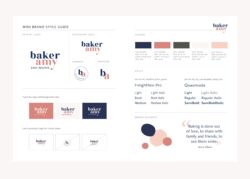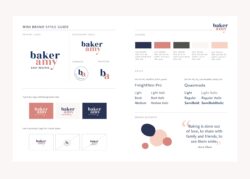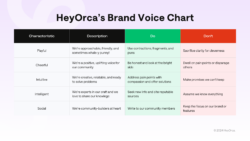Understanding the structure and components of these foundational documents is crucial for effective brand management. The following sections will delve into the key elements commonly included and offer practical guidance for development and implementation.

Key Components of a Brand Style Guide
A comprehensive brand style guide encompasses several crucial elements that work together to define and maintain a consistent brand identity. These components provide clear direction for anyone creating content or materials representing the organization.
1. Logo Specifications: This section details acceptable logo variations, including size, color, and placement restrictions. Clear usage guidelines prevent misrepresentation and maintain visual integrity.
2. Color Palette: Precise color codes (e.g., HEX, RGB, CMYK) for primary and secondary brand colors ensure consistent visual representation across various media. This section may also include guidelines for color usage in different contexts.
3. Typography: Specified font families, sizes, and weights for headings, body text, and other textual elements maintain readability and reinforce brand personality. Examples of proper usage can further clarify these guidelines.
4. Imagery: This section defines the preferred style and usage of images and graphics. It might include specifications for photography style, illustration guidelines, or iconography usage, ensuring visual cohesion.
5. Voice and Tone: Guidelines for written and verbal communication establish a consistent brand voice. This includes defining the overall tone (e.g., formal, informal, playful), preferred language, and grammar conventions.
6. Brand Messaging: Key brand messages and value propositions are outlined in this section. It ensures consistent communication of core brand values and helps maintain a unified brand narrative.
Adhering to these core elements allows organizations to present a cohesive and professional image across all platforms. A well-defined style guide empowers consistent brand representation, strengthens brand recognition, and streamlines the content creation process.
How to Create a Brand Style Guide
Developing a comprehensive brand style guide requires careful planning and execution. A structured approach ensures all essential elements are addressed, resulting in a valuable resource for maintaining consistent brand identity.
1. Conduct a Brand Audit: Begin by thoroughly analyzing existing brand materials. This includes reviewing current logos, marketing collateral, website content, and social media presence. This audit provides valuable insights into current brand representation and identifies areas for improvement or inconsistencies.
2. Define Brand Values and Mission: Clearly articulate the core values and mission that define the organization’s purpose and identity. These values serve as a foundation for all brand communications and inform the overall tone and style.
3. Determine Target Audience: Understanding the target audience is essential for tailoring brand messaging and visual elements effectively. Consider demographics, psychographics, and online behavior to create a style guide that resonates with the intended audience.
4. Develop Logo Variations and Usage Guidelines: Establish clear specifications for logo usage, including acceptable variations, size restrictions, and placement guidelines. Provide examples of correct and incorrect usage to prevent misrepresentation.
5. Define Color Palette and Typography: Select primary and secondary brand colors and provide precise color codes (HEX, RGB, CMYK). Specify font families, sizes, and weights for various textual elements, ensuring readability and visual consistency.
6. Establish Imagery and Iconography Guidelines: Define preferred image styles, including photography and illustration guidelines. If applicable, create a library of approved icons and provide usage instructions.
7. Craft Voice and Tone Guidelines: Outline the desired tone of voice for all brand communications, considering factors such as formality, humor, and personality. Provide examples of preferred language and grammar conventions.
8. Document Brand Messaging and Value Propositions: Clearly articulate key brand messages and value propositions. This ensures consistent communication of core brand values and helps maintain a unified brand narrative.
A well-structured brand style guide serves as a crucial tool for maintaining a consistent and impactful brand presence. By addressing these key components, organizations can ensure their brand is represented effectively across all platforms, strengthening brand recognition and fostering audience trust. Regular review and updates keep the guide relevant and aligned with evolving brand strategies.
A framework for consistent brand presentation across all platforms is essential for organizations seeking to establish a strong and recognizable identity. Such a framework provides clear guidelines for visual elements like logos, colors, and typography, as well as written communication, ensuring a unified brand experience for the target audience. A well-defined structure encompassing logo specifications, color palettes, typography guidelines, image usage, and voice and tone parameters empowers content creators to maintain brand integrity and streamlines the content creation process.
Maintaining a cohesive brand identity through a dedicated framework is not merely a stylistic exercise; it’s a strategic investment in long-term brand equity. Consistent brand representation fosters audience trust, strengthens brand recognition, and ultimately contributes to organizational success. Regular review and adaptation of these guidelines ensures continued relevance and effectiveness in a dynamic market landscape.



